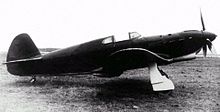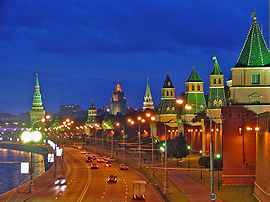- Marina Raskova
-
Marina Mikhailovna Raskova (Russian: Раско́ва Мари́на Миха́йловна; March 28, 1912 – January 4, 1943) was a famous Russian navigator. She later became one of over 800,000 women in the military service, founding three female air regiments which would eventually fly over 30,000 sorties in World War II.
Contents
Early life
Marina Raskova (née Malinina) was born to middle-class parents. Her father was a singing instructor and her mother a teacher. Unlike the majority of Soviet airwomen,[1] Marina did not show any early interest in aviation. [2] She became pilot-navigator purely by accident. Her parents wanted her to become a musician. ,[1] and her goal was to become an opera singer.
In October 1919, when she was seven, her father died from the injuries sustained when he was struck by a motorcycle.[1] Nevertheless, she continued her drama and singing studies but, being very strict on herself, she started to suffer from stress. She decided to quit music and to devote herself to study chemistry in high school and after graduation in 1929, started to work in in a dye factory as a chemist, to help her family. She married an engineer, Sergey Raskov, so changing her name to Raskova. She had a child, Tanya, in 1930. The following year she started to work in the Aero Navigation Laboratory of the Air Force Academy as a draftswoman. [2] Raskova became a famous aviator as both a pilot and a navigator for Russia in the 1930s. She was the first woman to become a navigator in the Soviet Air Force in 1933. A year later, she started teaching at the Zhukovskii Air Academy, also a first for a woman. In 1935, she divorced.[2] As significantly in the eyes of the Soviet Union, which gave its aviators celebrity status, she set a number of long distance records. Most of these record flights occurred in 1937 and 1938, while she was still teaching at the air academy.
The most famous of these records was the flight of the Rodina (Russian for "Motherland"), Ant-37 - a converted DB-2 long range bomber, on September 24–25, 1938. She was the navigator of the crew that also included Polina Osipenko and Valentina Grizodubova. From the start, the goal was to set an international women's record for a straight-line distance flight. The plan was to fly from Moscow to Komsomolsk (in the Far East). When finally completed, the flight took 26 hours and 29 minutes, over a straight line distance of 5,947 km (total distance of 6,450 km).
However, the ordeal took 10 days when the plane was unable to find an airfield due to poor visibility. Because the navigator's cockpit had no entrance to the rest of the plane and was vulnerable in a crash landing, Raskova parachuted out before they touched down. She had forgotten her emergency kit and was unable to find the plane for 10 days, with no water and almost no food. The rescue crew had found the aircraft 8 days after the landing, and was waiting when she found her way to it, after which all three women were taken to safety. On November 2, 1938, all three women were decorated with "The Hero of the Soviet Union" award, the first females ever to receive it and the only ones before World War II.
Great Patriotic War
When World War II broke out, there were numerous women who had training as pilots and many immediately volunteered. While there were no formal restrictions on women serving in combat roles, their applications tended to be blocked, run into red tape, etc. for as long as possible in order to discourage the applicants. Raskova is credited with using her personal connections with Joseph Stalin to convince the military to form three combat regiments of women. Not only would the women be pilots, but also the support staff and engineers for these regiments. This military unit was initially called Aviation Group 122 while the three regiments received training. After their training, the three regiments received their formal designations as follows:
The 586th Fighter Aviation Regiment (586 IAP/PVO): This unit was the first to take part in combat (April 16, 1942) of the three female regiments. Equipped with Yakovlev Yak-1, Yak-7B and Yak-9, it flew 4,419 flights.[3] destroying 38 enemy aircraft in 125 air battles. Commanders were Tamara Kazarinova and Aleksandr Gridnev.[4]
 A damaged and abandoned Po-2 forced to land in Ukraine, and subsequently captured by German troops, 1941. On this type of aircraft, the Night Witches flew more than 24,000 sorties
A damaged and abandoned Po-2 forced to land in Ukraine, and subsequently captured by German troops, 1941. On this type of aircraft, the Night Witches flew more than 24,000 sorties
The 46th Taman Guards Night Bomber Aviation Regiment: This was the best known of the regiments and was commanded by Yevdokia Bershanskaya. It originally began service as the 588th Night Bomber Regiment (588 NBAP), but was redesignated in February 1943 as recognition for service which would tally 24,000+ combat missions by the end of the war. The regiment produced 24 Heroes of Soviet Union.[5] Their aircraft was the Polikarpov Po-2, a very outdated biplane. The Germans were the ones however who gave them the name by which they are best known: The Night Witches (die Nachthexen). They were also the only one of the three regiments to remain solely female throughout the war, a distinction they went to some lengths to maintain.
The 125th Guards Bomber Aviation Regiment: Marina Raskova commanded this unit until her death in a flying accident, while leading two other Petlyakovs to their first operative airfield, near Stalingrad,[6] whereupon the unit was given to Valentin Markov. It started service as the 587th Bomber Aviation Regiment (587 BAP) until it was given the Guards designation in September 1943. The unit was given the very best of the Soviet bombers, the Petlyakov Pe-2, while many male units used obsolete aircraft, a factor which led to much resentment. The unit flew 1,134 missions, dropping over 980 tons of bombs. It produced five Heroes of Soviet Union.[7]
 Russian pilots and ground crew pose in front of a Pe-2 light bomber at Poltava, June 1944. Marina Raskova died while flying this type of aircraft in a flying accident, near Stalingrad
Russian pilots and ground crew pose in front of a Pe-2 light bomber at Poltava, June 1944. Marina Raskova died while flying this type of aircraft in a flying accident, near Stalingrad
As mentioned, Raskova was the commander of the 125th Guards Bomber Aviation regiment. She died on January 4, 1943, when her aircraft crashed attempting to make a forced landing on the Volga bank, while leading two other Pe-2s to first operative airfield near Stalingrad. The entire crew perished.[2] She received the first state funeral of the war.
Legacy
Her ashes were immured in the Kremlin Wall, beside Polina Osipenko's, on Red Square. She was posthumously awarded the Order of Patriotic War I Class. [8] She soon became the namesake of an American Liberty ship, the SS Marina Raskova, launched in June 1943.
A street was named after her in Moscow and Kazan' respectively, as well as a square in Moscow, some schools and Young Pioneer detachments. [9] There was a bust of her at the "M.M. Raskova"" Higher Air Force School in Tambov, but that school ceased to function in 1997.[10]
References
- ^ a b c Cottam 1998-Selected Biographies, p. 17.
- ^ a b c d Sakaida 2003, p. 15.
- ^ Pennington 2001, p. 125.
- ^ Pennington 2001, p. 104.
- ^ Pennington 2001, p. 72.
- ^ Pennington 2001, p. 93.
- ^ Pennington 2001, p. 90.
- ^ Cottam 1998-Selected Biographies, p. 27.
- ^ Cottam 1998-Selected Biographies, pp. 27-28.
- ^ Cottam 1998-Selected Biographies, p. 28.
Bibliography
- Cottam, Kazimiera Janina. Women in War and Resistance – Selected Biographies of Soviet Women Soldiers. Newburyport MA, Focus Publishing/R. Pullins Co. 1998. ISBN 1-58510-160-5.
- Milanetti, Gian Piero (2011) (in Italian). Le Streghe della Notte: La storia non detta delle eroiche ragazze-pilota dell'Unione Sovietica nella Grande Guerra Patriottica. Istituto Bibliografico Napoleone, Roma, Italia. ISBN 88-7565-100-0. http://www.calameo.com/books/0007962970324ec79c522.
- Wings, Women & War: Soviet Airwomen in World War II Combat, by Reina Pennington 2001, University Press of Kansas ISBN 978-070061554-4.*Sakaida, Henry (2003). Heroines of the Soviet Union: 1941-45. Osprey Publishing. ISBN 978-1-84176-598-3.
- Sorokina, M. A. "People and Procedures: Toward a History of the Investigation of Nazi Crimes in the USSR," Kritika: Explorations in Russian and Eurasian History, Volume 6, Issue 4, (2005) 797-831.
External links
Categories:- Russian navigators
- 1912 births
- 1943 deaths
- Aviators killed in aviation accidents or incidents
- Female aviators
- Heroes of the Soviet Union
- People buried in the Kremlin Wall Necropolis
- Russian people of World War II
- Soviet World War II pilots
- Soviet Air Force officers
- Soviet military personnel killed in World War II
- Women in the Russian and Soviet military
- Women in World War II
Wikimedia Foundation. 2010.



